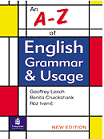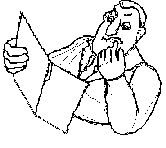

| Book of the Month | ||
 |
An A-Z of English Grammar and Usage |  |
Publisher: Longman
Authors: Geoffery Leech, Benita Cruickshank, Roz Ivanic
622 pages
Price £12.99
ISBN 582-40574-2
An A-Z of English Grammar and Usage is one of the standard books used by English teachers and students around the world. Now Longman have produced a new edition to replace all those copies that have been worn out by years of constant use. So how does the new version compare with its famous predecessor?
For those people who do not know this book, it is a sort of encyclopaedia of English Grammar. It is not like most grammar books because there are no exercises, and the explanations are given alphabetically, just as the name says. In this case, there are more than 600 entries, and many of these point to other entries - for instance if you look for 'he and she' you will find an explanation, but also a note telling you to also look at personal pronouns. The book is well laid out, and we had no problem in finding the points we wanted to look up. If we could not find them in the main book, the large index was very useful.
The team of writers who prepared the book begins with Geoffery Leech, who is a professor of Linguistics at Lancaster University, where Roz Inanic is also a lecturer. Benita Cruickshank is a Tefl teacher who has taught in a number of countries, and brings practical experience to the team. The main difference in the new edition of the book seems to be that the type is a bit bigger, and that there are plenty of black and white drawings in the book. These are mildly interesting, and help to break up the text, but they do not really add much. The large type makes the pages seem rather crowded, but this is a reference book, where you are going to be looking up particular grammar points, so the fact that it would be hard to read many pages at one time is not so important.
The book covers all grammar points well, including simple things like indirect speech, and matters for more advanced students such as subjectives and substantives. The authors also describe many of the common mistakes that non-native speakers make, and tell you the correct version. There are also quite a lot of functions - when to use particular phrases or different types of speech, and this is one place where the drawings really are useful. Our main criticism is that colloquial language and idiom is not very well covered, although this is a very large part of everyday English. Swearing and bad language have been left out completely. (Perhaps because this book is used in schools with children.)
Who is this book for? This is a useful book for an intermediate to upper-intermediate student of English who already has a standard grammar book but who wants a book that will give him a quick but accurate explanation. A slightly more advanced student - or a teacher - might want to look at Michael Swan's Modern English Usage before buying this book. Michael Swan's book also has grammar points arranged alphabetically, but there are fewer and longer explanations (and if you really have to swear in English, his book tells you exactly how to do it.)
Verdict: A very useful book for students and teachers. But not absolutely essential.
Assessment 8/10